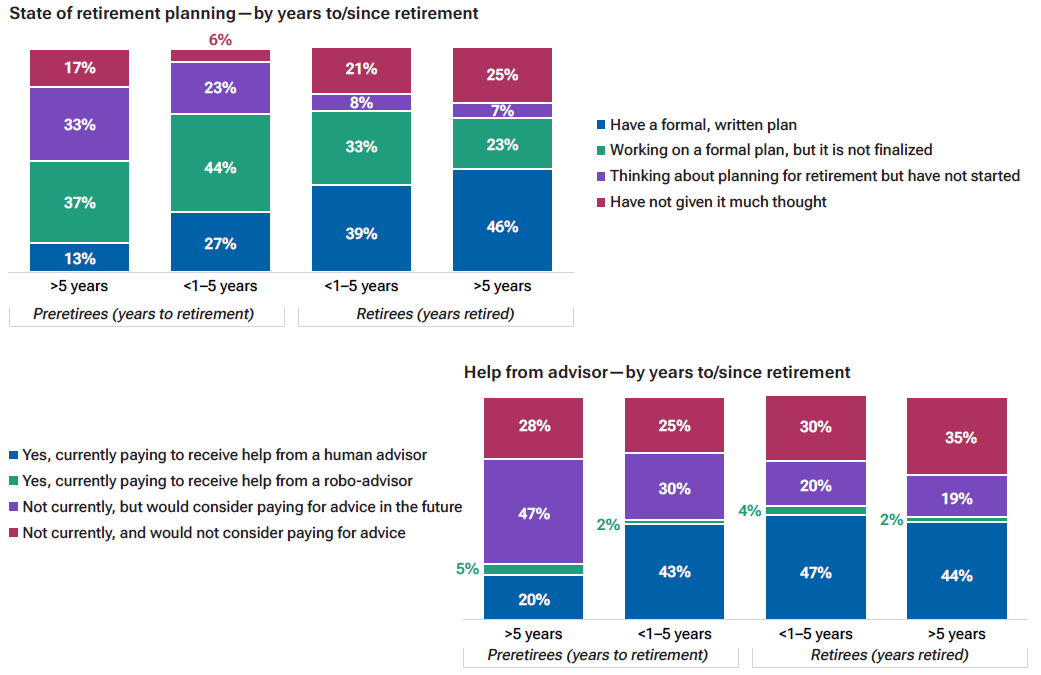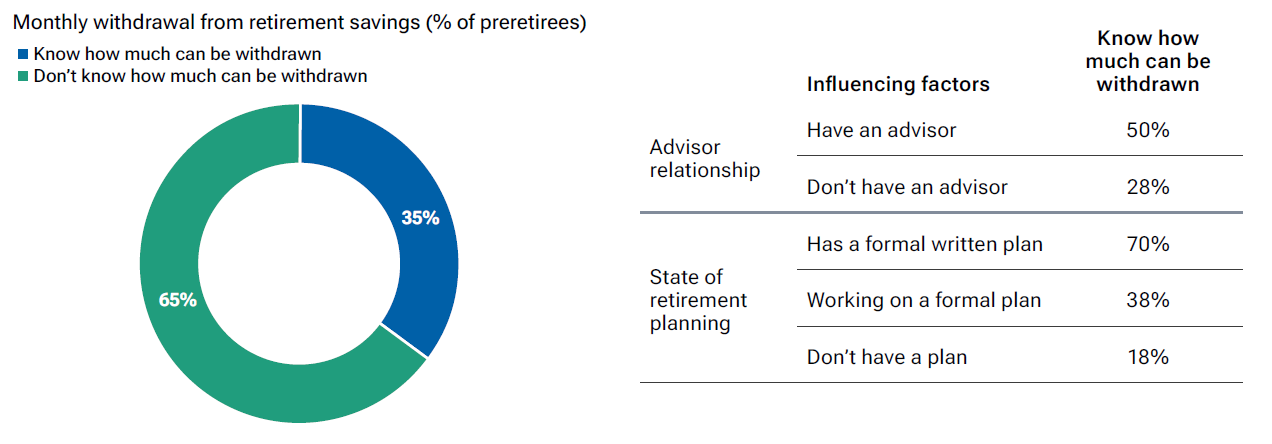retirement planning | march 20, 2025
Survey reveals the rising importance of financial planning at retirement
It’s important to establish a formal retirement withdrawal strategy leading into retirement.

Key Insights
Demand for financial planning services is strongest among investors in the five years leading up to and five years into retirement.
Retirement planning can improve investor confidence—62.5% of our survey respondents with a formal plan reported more confidence about their financial outlook.
Preretirees and retirees face complex decisions and need comprehensive solutions tailored to their unique situations.
The Pew Research Center estimates that 10,000 baby boomers are expected to turn age 65 each day until 2030. Unlike the saving phase of retirement, the spending phase is more complex and requires the coordination of many key decisions such as Social Security, Medicare, tax minimization, and legacy planning, as well as hedging against inflation, market, and longevity risk. As the narrative shifts from “How much do I need to retire?” to “How can I do better with what I have?,” most people don’t know where or how to start.
It is therefore not surprising that among the respondents in our 2023 T. Rowe Price Retirement Savings and Spending Study, 64% of baby boomers reported moderate to high levels of stress about their retirement savings. When preparing for retirement, individuals may benefit from educational resources and digital experiences to help them draft a formal plan that outlines expected expenses, income, and asset management strategies. Additionally, financial advisors are well positioned to offer support in developing a comprehensive retirement strategy.
A formal retirement plan is vital
Creating a formal written plan for retirement has shown some crucial benefits for preretirees, including boosting their confidence and excitement about retirement. The majority of our preretiree survey respondents were either in the process of forming a retirement plan or thinking about it. For preretirees who were within five years of retirement and for retirees in the five years after their retirement date, data showed a meaningful increase in formal retirement planning, including seeking help from a financial advisor (Fig. 1).
Most retirees form a plan for retirement or seek help from advisors in the five years before and after retirement
(Fig. 1)

Source: T. Rowe Price Retirement Savings and Spending Study, 2023.
Numbers may not total 100% due to rounding.
Preretirees may find value in a range of services that will help them plan for retirement. These can include specialized education to help with the withdrawal and income phase or with key decisions such as when to collect Social Security. A formal retirement plan may include an understanding of retirement goals; an investment strategy that considers different accounts across the household, such as taxable, tax‑deferred, and Roth; and how to spend down these assets in a tax‑efficient manner. Additionally, past academic research has shown that an actively managed retirement plan that looks across a household to generate income can add up to seven more years of savings longevity.1 Our survey shows that having a formal retirement plan improves investors’ confidence about their retirement outlook (Fig. 2).
Subscribe to T. Rowe Price Insights
Receive monthly retirement guidance, financial planning tips, and market updates straight to your inbox.
Having a formal plan can improve confidence about retirement outlook
(Fig. 2) Preretirees’ confidence about retirement

Source: T. Rowe Price Retirement Savings and Spending Study, 2023.
Could you benefit from financial advice?
A guide to determining whether your circumstances may warrant expert support
T. Rowe Price research has revealed the factors and circumstances that lead many investors to find value in paying for financial advice. Consider the following questions to determine whether the same may be true for you. If you answer yes to some of the following questions, it may benefit you to discuss your situation with a financial professional.
Do you have assets in a mix of tax‑deferred, tax‑free, and taxable accounts?
Are you approaching retirement and want to make sure your assets will last?
Have you recently been widowed or divorced and are seeking financial guidance?
Do you have a need for tax and estate planning services or help coordinating with those specialists?
Do you typically find it helpful to talk about your financial goals and priorities?
Are you concerned about making emotion‑driven investing decisions?
Limited knowledge could lead to uninformed decisions
Among preretirees, awareness is low when considering investment products that offer packaged solutions designed to support investors’ retirement income needs. In our study, 35% to 56% of preretirees reported that their understanding of investments, such as managed accounts, fixed income products, target date, and managed payout funds, were not very good or not good at all. This limited level of knowledge also applied to preretirees working with an advisor.
In addition, 65% of preretirees do not know how much can be withdrawn from their retirement savings (Fig. 3). Even estimates from knowledgeable preretirees may not be accurate. This is a problem, as overspending could deplete retirement assets early, while underspending could impede financial satisfaction.2
Most preretirees do not know how much they can withdraw each month from their retirement savings
(Fig. 3)

Source: T. Rowe Price Retirement Savings and Spending Study, 2023.
Financial advisors can help investors make the most of the assets in their various accounts and sequence withdrawals in a tax‑efficient manner while coordinating when to claim Social Security benefits. Advisors can also help retirees plan for health care needs, the needs of a surviving spouse, and how retirees might want their assets distributed to their heirs. In particular, financial plans that include detailed personalized and actionable guidance that incorporate the household’s retirement accounts as well as coordinate both investment and non‑investment decisions a retiree faces can be very beneficial.
Would you like a financial plan that keeps up as your goals change?
A guide to determining whether your circumstances may warrant expert support
Consider the T. Rowe Price Retirement Advisory Service™.
If you’re looking for additional information beyond what you can find online, it’s easy to get started with a detailed, personalized financial plan that you can review without cost or commitment. And we make it easy to put your plan into action.
Simply enroll in our managed portfolio service with a competitive average net advisory fee of 0.5%1 (minimum account balance of $250,000).
Enjoy the ongoing support of a dedicated advisor in your corner.
You can feel confident with our professionals managing your investments, so you can focus on the people and activities you love.
Our advice and investment professionals have your back through every kind of market. T. Rowe Price also has tools, such as our Retirement Income Calculator, Social Security Optimizer, and Auto‑RMD Tool, along with educational content like the articles you can find in our Insights library.
Explore advice with us now. Or call 1‑800‑366‑5910 to speak with a Financial Consultant.
1The average net advisory fee for the service assumes the use of primary funds and neutral portfolio weightings. Your actual net advisory fees will vary depending on your recommended model portfolio, the specific mix of funds in your managed portfolio, and their fees and expenses. The estimated net advisory fees for the model portfolios ranged from 0.37% to 0.57% as of June 2024. You will also pay the fees and expenses of the funds held in your managed portfolio. The total cost you are expected to pay, including the net advisory fee and the underlying fund fees and expenses, is approximately 1.00% of assets under management. For additional information on fees and expenses of the service, please read the Fees and Compensation section of the Retirement Advisory Service ADV Brochure (PDF).
The T. Rowe Price Retirement Advisory Service™ is a nondiscretionary financial planning and retirement income planning service and a discretionary managed account program provided by T. Rowe Price Advisory Services, Inc., a registered investment adviser under the Investment Advisers Act of 1940. Brokerage accounts for the Retirement Advisory Service are provided by T. Rowe Price Investment Services, Inc., member FINRA/SIPC, and are carried by Pershing LLC, a BNY Mellon company, member NYSE/FINRA/SIPC, which acts as a clearing broker for T. Rowe Price Investment Services, Inc. T. Rowe Price Advisory Services, Inc. and T. Rowe Price Investment Services, Inc. are affiliated companies.
Final thought
Given the number of complex decisions facing retirees as they seek to maintain an income stream from their savings, the need for financial planning and related guidance may seem obvious. Similarly, individuals with a plan are clearly less stressed and more confident about their future. The results of our survey imply the immense value of financial advisors and digital planning tools for investors, as well as educational content, to provide retirees a greater peace of mind.
Retirement Savings and Spending Study
The Retirement Savings and Spending Study is a nationally representative online survey of 401(k) plan participants and retirees. The survey has been fielded annually since 2014. The 2023 survey was conducted between July 24, 2023, and August 13, 2023. It included 3,041 401(k) participants who were full‑time or part‑time workers who never retired, currently age 18 or older, and either contributing to a 401(k) plan or eligible to contribute with a balance of $1,000 or more. The survey also included 1,176 retirees who have retired with a Rollover IRA or left a 401(k) plan balance.
1Meyer and Reichenstein, Journal of Financial Planning, “How the Social Security Claiming Decision Affects Portfolio Longevity,” 2012, and Cook, Meyer, and Reichenstein, Financial Analyst Journal, “Tax‑Efficient Withdrawal Strategies,” 2015.
2Banerjee, Sudipto, Planning for Spending Volatility in Retirement, 2023.
Important Information
This material is provided for general and educational purposes only and is not intended to provide legal, tax, or investment advice. This material does not provide recommendations concerning investments, investment strategies, or account types; it is not individualized to the needs of any specific investor and not intended to suggest any particular investment action is appropriate for you.
Any tax‑related discussion contained in this material, including any attachments/links, is not intended or written to be used, and cannot be used, for the purpose of (i) avoiding any tax penalties or (ii) promoting, marketing, or recommending to any other party any transaction or matter addressed herein. Please consult your independent legal counsel and/or tax professional regarding any legal or tax issues raised in this material.
The views contained herein are as of the date written and are subject to change without notice; these views may differ from those of other T. Rowe Price associates.
This information is not intended to reflect a current or past recommendation concerning investments, investment strategies, or account types, advice of any kind, or a solicitation of an offer to buy or sell any securities or investment services. The opinions and commentary provided do not take into account the investment objectives or financial situation of any particular investor or class of investor. Please consider your own circumstances before making an investment decision.
Information contained herein is based upon sources we consider to be reliable; we do not, however, guarantee its accuracy.
Past performance is not a reliable indicator of future performance. All investments are subject to market risk, including the possible loss of principal. All charts and tables are shown for illustrative purposes only.
T. Rowe Price Investment Services, Inc., distributor, and T. Rowe Price Associates, Inc., investment adviser.
202503-4303981
Next Steps
Learn How to make your retirement account withdrawals work best for you.
Contact a Financial Consultant at 1-800-401-1819.